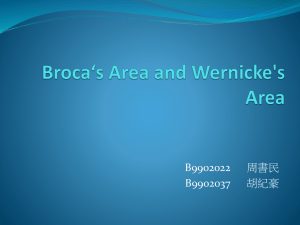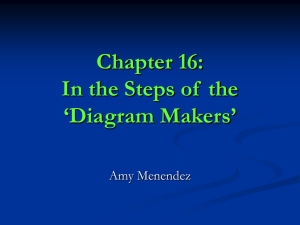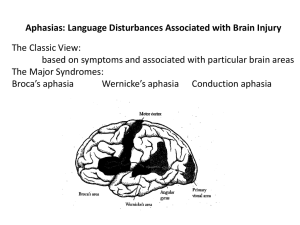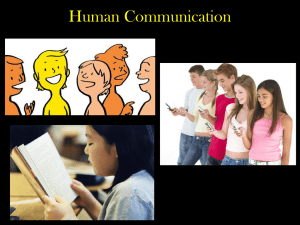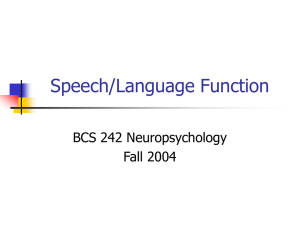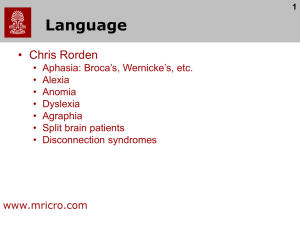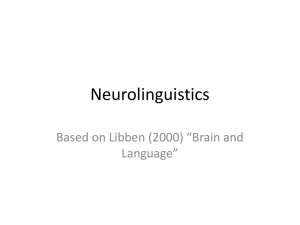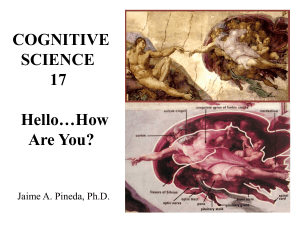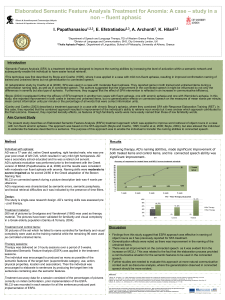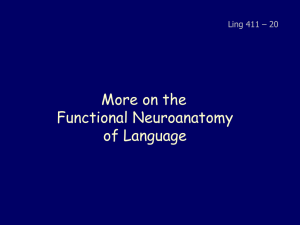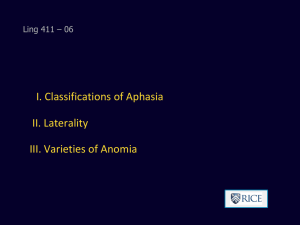ling411-07-Localization - OWL-Space
advertisement
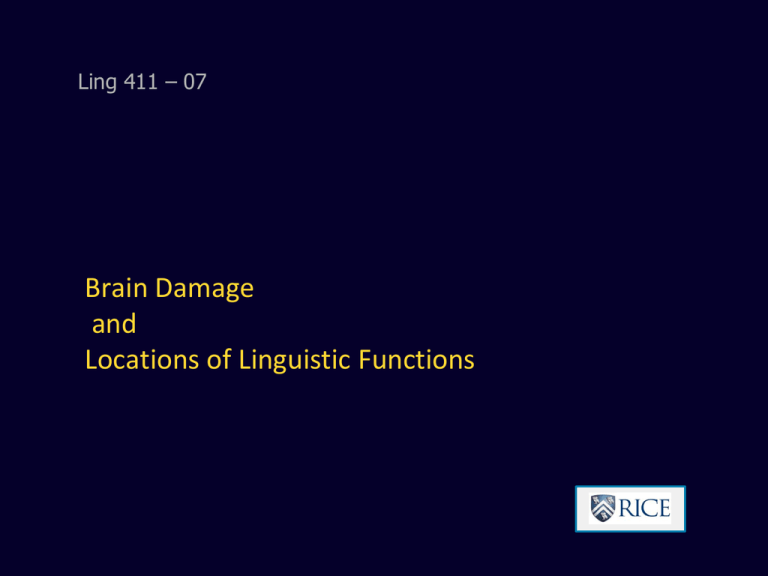
Ling 411 – 07 Brain Damage and Locations of Linguistic Functions Why so much variation in symptoms? Difference in areas of brain damage Difference in kinds of brain damage • Strokes vs trauma vs infection vs tumors • Different kinds of stroke Anatomical variation among people • Differing cortical structures • Differences in vascular anatomy Difference in location of cortical functions Why so much variation in symptoms? Difference in areas of brain damage Difference in kinds of brain damage • Strokes vs trauma vs infection vs tumors • Different kinds of stroke Anatomical variation among people • Differing cortical structures • Differences in vascular anatomy Difference in location of cortical functions Different types of brain damage Strokes, wounds, tumors, infections, degenerative disease Each of these occurs in varying locations Each of these has varying extent of damage Different Kinds of Stroke Damage 1. Ischemic: blockage of artery • Two sources of blockage: 1. Thrombosis (about 2/3 of all ischemic strokes) (B&A 64) 2. Embolism: caused by a blood clot, air bubble, or detached clot • Result: infarction – death of brain tissue that is no longer receiving blood supply • Variation in location of blockage • Hence, variation in area of infarction 2. Hemorrhagic: bleeding into cerebral tissues • Variation in location and extent of hemorrhage Stroke mechanisms http://www.youtube.com/watch?v=M_fo6ytlmD0&feature=related Why so much variation in symptoms? Difference in areas of brain damage Difference in kinds of brain damage • Strokes vs trauma vs infection vs tumors • Different kinds of stroke Anatomical variation among people • Differing cortical structures • Differences in vascular anatomy Difference in location of cortical functions Cerebral Arteries Anterior Cerebral Artery • Feeds frontal pole and most of the medial surface Middle Cerebral Artery • Feeds most of cortex, Perisylvian area Other areas Posterior Cerebral Artery • Feeds bottom of temporal lobe and medial surface of occipital and parietal lobes View of actual brain with arteries http://www.youtube.com/watch?v=Qn4NArz385U&feature=related Left hemisphere, showing middle cerebral artery Middle Cerebral Artery (Right Hemisphere) www.strokecenter.org/education/ais_vessels/ais049b.html The middle cerebral artery is the largest branch of the internal carotid. The artery supplies a portion of the frontal lobe and the lateral surface of the temporal and parietal lobes, including the primary motor and sensory areas of the face, throat, hand and arm and in the dominant hemisphere, the areas for speech. The middle cerebral artery is the artery most often occluded in stroke. From Washington University Medical School Middle Cerebral Artery Inter-Subject Variability Aphasic syndromes and Cerebrovascular areas Territory Aphasic syndrome • Anterior cerebral artery occlustion Extrasylvian motor aphasia • Posterior cerebral artery occlusion Occipital alexia • Middle cerebral artery occlusion Various major types of aphasia (next slide) Aphasias with middle cerebral artery occlusion Total artery occlusion Global aphasia Orbitofrontal branch Broca aphasia Rolandic branch Broca aphasia, cortical dysarthria Anterior parietal branch Conduction aphasia Posterior parietal branch Angular branch Wernicke aphasia, extrasylvian sensory aphasia Anomia, extrasylvian sensory aphasia Posterior temporal branch Wernicke aphasia Anterior temporal branch Anomia Why so much variation in symptoms? Difference in areas of brain damage Difference in kinds of brain damage • Strokes vs trauma vs infection vs tumors • Different kinds of stroke Anatomical variation among people • Differing cortical structures • Differences in vascular anatomy Difference in location of cortical functions Neuroanatomical correlates of the aphasias Identifying linguistic functions Locating linguistic functions Evaluating evidence from aphasia It would be easy if naïve localization were true • If a patient has lost an ability, then the area of damage is the area responsible for that ability But naïve localization is false “… language, along with other complex cognitive processes, depends on the concerted operation of multicomponent, large-scale neural systems. The anatomical components are often widely dispersed and each acts as a partial contributor to a complicated process…” Antonio Damasio 1998:25 Simple Functions / Complex Functions Complex function Simple function Suppose this area gets knocked out. Then the whole complex function is impaired Benson and Ardila on conduction aphasia “… a single type of aphasia may have distinctly different loci of pathology. Both conduction aphasia and transcortical motor aphasia are examples of this inconsistency.” (117) (See also p. 135) Hannah Damasio on conduction aphasia “Conduction aphasia is associated with left perisylvian lesions involving the primary auditory cortex…, a portion of the surrounding association cortex…, and to a variable degree the insula and its subcortical white matter as well as the supramarginal gyrus (area 40). Not all of these regions need to be damaged in order to produce this type of aphasia. In some cases without involvement of auditory and insular regions, the compromise of area 40 is extensive…. In others, the supramarginal gyrus may be completely spared and the damage limited to insula and auditory cortices … or even to the insula alone….” (1998: 47) CT template – Conduction Aphasia (patient I) CT template – Conduction Aphasia (patient II) Left auditory cortex and insula MR template – Wernicke Aphasia (patient I) Posterior portion of superior and middle temporal gyri MR template – Wernicke Aphasia (patient II) Superior temporal gyrus, AG, SMG CT template – Broca Aphasia (patient I) Superior sector of Broca’s area and the premotor region immediately above it MR template – Broca Aphasia (patient II) Most of Broca’s area, motor and premotor regions, white matter, insula MR template – Transcortical Motor Aphasia Motor and premotor cortices just above Broca’s area Two different patients with anomia Inability to retrieve words for unique entities Deficit in retrieval of animal names (Left temporal lobectomy) (Damage from stroke) Two more patients with anomia Deficit in retrieval of words for man-made manipulable objects (Damage from stroke) Severe deficit in retrieval of words for concrete entities (Herpes simplex encephalitis) More on these four anomic patients “…anomic aphasia requires damage to left temporal cortices located outside the traditional aphasia-producing territories” (Hannah Damasio 1998:50) All of these four subjects demonstrated normal concept retrieval for the concrete entities they could not name (Hannah Damasio 1998:51) (But she does not elaborate – maybe it’s not really “normal” – possibly RH conceptual knowledge?) Don’t forget this – (repeating) Some information is bilaterally represented • Highly entrenched items • Initial consonants of high-frequency words (?) • Some people have more bilateral representation than others • Women and left-handers tend to have more bilateral representation than men and righties Semantic information is in both LH and RH • But different aspects of semantic information Metaphor, irony, sarcasm, pragmatic features, inferencing, subserved by RH Conceptual category dissociation I (from Rapp & Caramazza 1995) J.B.R. and S.B.Y. (905b-906a) Herpes simplex encephalitis Both temporal lobes affected Could not define animate objects • ostrich, snail, wasp, duck, holly Much better at defining inanimate objects • tent, briefcase, compass, wheelbarrow, submarine, umbrella How to explain? Conceptual category dissociation II J.J. and P.S. (Hillis & Caramazza 1991) (906-7) • J.J. – left temporal, basal ganglia (CVA) Selective preservation of animal concepts • P.S. – mostly left temporal (injury) Selective impairment of animate category P.S J.J. MR template – Transcortical Sensory Aphasia AG and posterior SMG Transcortical sensory aphasia (A. Damasio 1998:36) Fluent and paraphasic speech • Global paraphasias Severe impairment in oral comprehension Repetition intact (unlike Wernicke’s aphasics) N.b.: Refers to H. Damasio, Chapter 3, for localization of damage Brain damage and nominal concepts Access to nominal concepts is impaired in extra-sylvian sensory aphasia Type I – Damage to temporal-parietaloccipital junction area • I.e., lower angular gyrus and upper area 37 • Poor comprehension • Naming strongly impaired • Semantic paraphasia Type II – Damage to upper angular gyrus • Variable ability to comprehend speech • Naming strongly impaired • Few semantic paraphasias • Many circumlocutions Benson & Ardila 1996 Summary: Correlations of symptoms with areas of lesion Aphasic Syndrome Area of Damage Broca’s Broca’s area Wernicke’s Wernicke’s area Conduction SMG, Insula, Arcuate fasciculus Transcortical motor Areas anterior and/or superior to Broca’s area Transcortical sensory Areas posterior and/or superior to Wernickes a. Cf. H. Damasio 1998: 43-44 Correlation of aphasia types to localization of damage “More than 100 years of study of anatomoclinical correlations, with autopsy material as well as CT and MR scans, has proven that in spite of the inevitable individual variability, the correlation between aphasia types and locus of cerebral damage is surprisingly consistent.” Hannah Damasio 1998: 64 Correlation of linguistic functions to localization of aphasic damage “…the correlations per se provide only limited information about the neurobiological mechanisms of language, in health and in disease.” Hannah Damasio 1998: 64-6 Reasoning from brain damage to localization If area A is damaged and patient has deficit D of some function F Does this mean that function F is subserved by area A? Not really.. It means that A (or some portion of A) is needed for some component of F Brain damage and localization of function Hypothetical example A function Damage Reading and Writing Alexia and Agraphia Alexia with agraphia • Reading and writing both impaired • A rare disorder Patients with both impairments usually also have Wernicke’s aphasia or transcortical sensory aphasia Alexia without agraphia, a.k.a. pure alexia • Reading impaired, writing okay • Can write spontaneously or to dictation • Some can copy writing but with difficulty Misprint in Antonio Damasio Reading Antonio Damasio, Signs of Aphasia P. 38: “As the designation implies, patients presenting alexia with agraphia become unable to read while they continue to be able to write…” Should be “…alexia without agraphia…” More on patient J.G. Damage: Left posterior temporal-parietal Meaning spared, phonological recognition okay, but couldn’t spell the word correctly • digit: D-I-D-G-E-T “A number” • thief: T-H-E-F-E “A person who takes things” These spellings are not correct, but.. Rapp & Caramazza 1995 Reading – relating writing to speech Phonological word image Phonemes The “Phonics” route Letters Reading – relating writing to speech Phonological word image Graphic word image The “whole word” route Letters Two pathways for relating writing to speech Phonological word image Graphic word image Phonemes Letters Redundancy? Two pathways for relating writing to speech The “whole word” route is necessary for • caught • island • sign The “phonics” route is needed for long unfamiliar words • commissurectomy • prosopagnosia • magnetoencephalography The spelling attempts of J.G. (one more look) digit: • D-I-D-G-E-T • “A number” thief: • T-H-E-F-E • “A person who takes things” J.G. has damaged “whole word” route but intact “phonics” route Evidence that the two routes are separately represented in the cortex More evidence on phonological and graphic forms Patient P.W. (905) • Damage: anterior parietal & posterior frontal • Tested on identifying spoken words [skirt]: “S-O-C-K, skirt” • Verbal paraphasia in spelling but not in speech [brush]: “B-R-U-S-H, comb” • Verbal paraphasia in speech but not in spelling [knife]: “S-P-O-O-N, fork” • Verbal paraphasia in both modalities The paraphasias are semantically related Connecting graphic representation to meaning The traditional view: speech is primary, writing secondary • History • Development Might suggest that writing has access to meaning only via phonological representation But evidence from brain damage indicates that (at least some) written forms have direct access to meaning, independently of phonology Pathway to meaning Conceptual information Phonological word image Graphic word image Phonemes Letters Patient D.R.B. (Rapp &Caramazza 1995: 902b-903a) Left middle cerebral artery infarct Able to discriminate words and pseudo-words • Either visual or auditory input Test: Two words – synonyms or not? • For written input, 95% accurate • For spoken input, only 61% accurate Evidence that representations of written words can have direct connections to semantic information Two pathways to meaning Conceptual information Another pathway Phonological word image Graphic word image Phonemes Letters Evidence for direct connections between meaning and graphic form Patient D.R.B. (above) • Judgments of synonymy better for pairs of written words than pairs of spoken words Patient R.G.B (next slide) Patient H.W. (904) Evidence for direct connections between meaning and graphic form – Patient R.G.B. (R&C 1995: 904) Damage: left fronto-parietal Tested on identifying written words Semantic errors in spoken output • Records (written form) Spoken response: “radio” • Wrong but semantically related But gets the meaning: “You play ‘em on a phonograph … can also mean notes you take and keep” Assessment: Gets the meaning from written input, but has impaired phonological information or impaired connection to phonological information Evidence for direct connections between meaning and graphic form – Patient H.W. (R&C 1995: 904) Damage: left parietal and occipital Tested on identifying written words • Interest: “bank” (spoken response) • Wrong but semantically related “You go to the bank and put it in and you get more money … not very much now” • Indicates that the meaning was correctly accessed Phonological-Graphic Connections: The Angular Gyrus The angular gyrus and the white matter below it appear to be uniquely important for all aspects of graphic language that involve its linkage to writing, to spoken language, and to word meaning. Injury to this area disrupts not only the ability to understand the written word, but also disrupts related knowledge such as oral spelling and letter-sound correspondence, and therefore disrupts the ability to write. Harold Goodglass Understanding Aphasia 1993:51 The angular gyrus Angular gyrus Connecting to spoken output Phonological word image Graphic word image Phonological production Phonemes Letters Broca’s area Arcuate fasciculus Wernicke’s area Angular gyrus Connecting to Spoken and Written Output Exner’s area Graphic production Superior longitudinal fasciculus Phonological word image Graphic word image Phonological production Phoneme images Broca’s area Arcuate fasciculus Wernicke’s area Letter images Angular gyrus Exner’s Area Broca’s area Wernicke’s area Angular gyrus end
